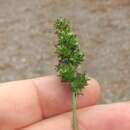Comprehensive Description
(
Inglês
)
fornecido por North American Flora
Carex plana Mackenzie, Bull. Torrey Club 50: 350. 1923
Carex Muhlenbergii var. enervis Boott, 111. Carex 124. pi. 400. 1862. (Type from Highlands, New York.) Not C. enervis C. A. Meyer, 1833.
Carex Muhlenbergii var. xalapensis Britton ; Britt. & Brown, 111. Fl. 1 : 349. 1896. (As to plant described only.)
Cespitose, from lignescent, short-prolonged, dark, fibrillose rootstocks, the culms 3-9 dm. high, slender but stiff, sharply triangular, rough above, leafy on lower fifth, much exceeding the leaves, light-brownish at base, the dried-up leaves of the previous year conspicuous; leaves with well-developed blades 5-10 to a culm, the blades erect-ascending, thickish, green, usually 1-3 dm. long, 2-3 mm. wide, flat or channeled at base, long-tapering, roughened towards apex and on the margins, the sheaths tight, not septate-nodulose, little if at all cross-rugulose, concave and thickened and yellowish-brown-tinged at mouth, the ligide conspicuous, about as wide as long; spikes 5-10, androgynous, densely aggregated into an oblong head 2-4 cm. long, 8-10 mm. thick, the lower at least well-defined and distinguishable, the staminate flowers few, with ovate-lanceolate cuspidate scales, the 8-20 perigynia ascending or at length spreading; bracts bristle-form, short but at least the lowest conspicuous; scales ovate, greenish-hyaline with 3-nerved green center, cuspidate or aristate, narrower than and (excluding awn) from somewhat shorter than to about length of bodies of perigynia; perigynia plano-convex, 3-3.5 mm. long, 2-2.25 mm. wide, ovate, broadest below middle, round-tapering and slightly spongy at base, subcoriaceous, light-green or in age yellowish-green, narrowly margined nearly to base, severalto rather many-ribbed dorsally, nerveless or short-nerved at base ventrally, flat or nearly so ventrally, serrulate from above the middle, abruptly short-beaked, the beak 1 mm. long, rather broadly bidentate with short triangular teeth, hyaline within, both sutures conspicuous; achenes lenticidar, ovoid-orbicular, 2 mm. long, 1.75 mm. wide, filling body of perigynium, abruptly substipitate, not at all or very shortly apiculate; style short, slender, enlarged at base, jointed with achene; stigmas two, reddish-brown, slender, long.
Type locality (of C. Muhlenbergii var. enervis Boott, on which C. plana is based) : Highlands. Hudson lUver, New York {Russell) ; figured by Boott. P.«T I, 1931] CYPERACEAE 57
Distribution: Dry hillsides, especially in calcareous regions, Maine and Ontario to Nebraska, and southward to Alabama and Texas. Especially well distributed and abundant in the strongly calcareous districts of the Mississippi Valley. (Specimens examined from Maine, Massachusetts, Rhode Island. Connecticut, Ontario, New York, New Jersey, Pennsylvania. Delaware, Maryland, District of Columbia. Virginia, North Carolina, South Carolina, Alabama, Mississippi, Kentucky, Tennessee, Ohio, Indiana. Michigan, Illinois. Iowa, Nebraska, Missouri, Kansas, Oklahoma, Arkansas, Texas.)
- citação bibliográfica
- Kenneth Kent Mackenzie. 1931. (POALES); CYPERACEAE; CYPEREAE (pars). North American flora. vol 18(1). New York Botanical Garden, New York, NY
Comprehensive Description
(
Inglês
)
fornecido por North American Flora
Carex onusta Mackenzie, Bull. Torrey Club 42: 618. 1915
Cespitose, from stout, short-creeping, black, fibrillose rootstocks, the culms aphyllopodic, 2-3.5 dm. high, stiff but rather slender, bluntly triangular below, sharply triangular and roughened above, exceeding leaves, brownish at base, biennial, the dried-up leaves conspicuous; leaves with well-developed blades 3 or 4 to a fertile culm, the sheaths tight, ver>' inconspicuously septate-nodulose dorsally, cross-rugulose ventrally and strongly thickened at mouth, the ligule wider than long, the blades light-green, flat, thick, mostly 1-2 dm. long, 2.5-4.5 mm. wide; head oblong or oblong-ovoid, dense, 1.5-3 cm. long, 8-13 mm. thick, containing 8-15 androgynous spikes, only the lower readily distinguishable: lower bracts setaceous, shorter than head, the upper scale-like; spikes with 5-15 appressed or at length spreading or ascending perigynia, the apical staminate flowers usually forming a conspicuous but short cone; scales ovate, ver>' thin, cuspidate, hyaline, yellowish-browntinged, with green midvein, narrower than and about two thirds length of bodies of perignia; perig>-nia plano-convex or slightly biconvex, oblong-ovate, 3 mm. long, 1.5 mm. wide, submembranaceous, green or in age yellowish-green, nerveless ventrally, obscurely few-nerved dorsally, sharply margined to the rounded non-spong>' base, the margins not elevated, serrulate towards beak, abruptly beaked, the beak 0.75 mm. long, serrulate, bidentate, the teeth short, the dorsal suture and false ventral suture conspicuous; achenes lenticular, filling body of perig>-nium, 2.5 mm. long, 1.5 mm. wide, minutely truncately apiculate, the style short, slender, with much enlarged base, jointed with achene; stigmas two, short, slender, reddish-brown.
Type locality: Sandy woods, Tarrant County, Texas {A. Ruth 458).
Distribution: Known only from the type locality.
- citação bibliográfica
- Kenneth Kent Mackenzie. 1931. (POALES); CYPERACEAE; CYPEREAE (pars). North American flora. vol 18(1). New York Botanical Garden, New York, NY

